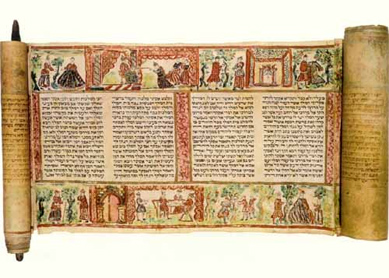The book of Esther is the Hebrew Bible’s very own melodrama. The king of Persia, Ahasuerus, takes the beautiful Jewish maiden, Esther, as his wife. But Haman, his chief minister, hates the Jew Mordecai and plans genocide. What will become of the Jews? What will Esther do to help her people?
We cannot be certain of the time and place of the book’s authorship. In addition, the author is not simply recounting events. Rather, the writer of Esther chooses to emphasize potential anti-Jewish violence and the reactions to it in order to help Jews live under the sometimes-dangerous rule of the empire.
The writer of Esther roots anti-Jewish violence in an ancient ethnic conflict with the Amalekites. Haman, the “enemy of the Jews” (Esth 3:10), is an Agagite, a descendant of the Amalekite king Agag, whom Saul famously failed to kill (Esth 3:1; 1Sam 15:8-9). Mordecai, a descendent of Kish, Saul’s father, thus has a natural enmity toward Haman. This may explain Mordecai’s refusal to bow before Haman (Esth 3:2), which sets off Haman’s attempted genocide.
Why would the author make this conflict the starting point?
Claiming ethnic origins for this anti-Jewish violence frees the Persian Empire from blame. Haman does not tell the king which people he intends to destroy, simply describing them as dangerously different (Esth 3:8-11). The book differs from other early Jewish texts in which emperors themselves design anti-Jewish violence (1Macc 1:44-64; 2Macc 6-7; 3Macc 3:27-30).
For the writer, the Persian Empire is no opponent of the Jews. Esther marries Ahasuerus (despite common Jewish opposition to intermarriage; Ezra 9:1-15; Neh 13:23-27; Deut 7:3-4). Together Esther and Mordecai save Ahasuerus’s life (Esth 2:19-23). Persian court officials assist Esther (Esth 2:8-9, Esth 2:15; Esth 4:5-17). Persian residents of Susa are “thrown into confusion” when Haman’s plan is announced (Esth 3:14-15) but rejoice and even seek to join the Jews when Mordecai issues an edict allowing Jewish resistance to the planned pogrom (Esth 8:15-17).
Yet the empire is a dangerous place for Jews. The king is an unstable autocrat. While powerful enough to throw fine parties (Esth 1:1-9) and to kill those he wishes to kill (Esth 2:23; Esth 7:10), he cannot ensure his wife’s presence at a banquet (Esth 1:12), is often inebriated and/or angry (Esth 1:8-12; Esth 2:1; Esth 3:15; Esth 5:6; Esth 7:2, Esth 7:7, Esth 7:10), and even executes Haman for the wrong reason (Esth 7:8). In this kind of empire, Mordecai initially feels it prudent for Esther to hide her Jewish identity at court (Esth 2:10). The empire is also apparently full of “enemies of the Jews” (Esth 9:1) ready to attack the Jews on the given day.
In this imagined empire, the writer gives a threatened community relief by imagining a complete reversal, with the would-be victims of violence—the Jews—visiting suffering and death on their enemies. This change of status becomes part of the celebration of Purim (Esth 9:20-32). But this reversal only occurs within the bounds of imperial permission, permission secured more by beauty and cleverness than by direct divine action, which is absent. Like the characters in the book, the audience may find such a strategy leads to a successful life under the empire.



